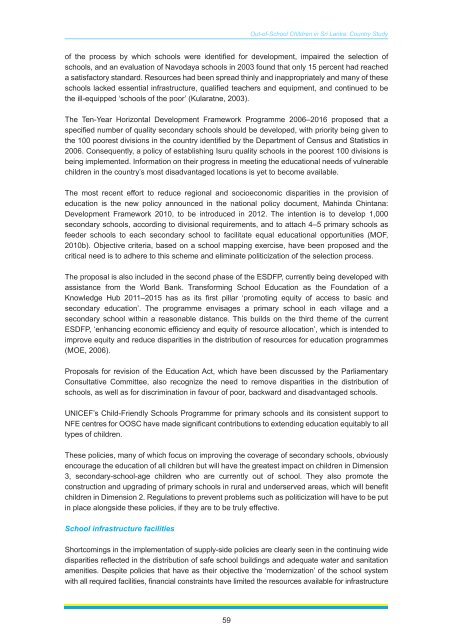Sri Lanka - Institut de statistique de l'Unesco
Sri Lanka - Institut de statistique de l'Unesco
Sri Lanka - Institut de statistique de l'Unesco
Create successful ePaper yourself
Turn your PDF publications into a flip-book with our unique Google optimized e-Paper software.
Out-of-School Children in <strong>Sri</strong> <strong>Lanka</strong>: Country Study<br />
of the process by which schools were i<strong>de</strong>ntified for <strong>de</strong>velopment, impaired the selection of<br />
schools, and an evaluation of Navodaya schools in 2003 found that only 15 percent had reached<br />
a satisfactory standard. Resources had been spread thinly and inappropriately and many of these<br />
schools lacked essential infrastructure, qualified teachers and equipment, and continued to be<br />
the ill-equipped ‘schools of the poor’ (Kularatne, 2003).<br />
The Ten-Year Horizontal Development Framework Programme 2006–2016 proposed that a<br />
specified number of quality secondary schools should be <strong>de</strong>veloped, with priority being given to<br />
the 100 poorest divisions in the country i<strong>de</strong>ntified by the Department of Census and Statistics in<br />
2006. Consequently, a policy of establishing Isuru quality schools in the poorest 100 divisions is<br />
being implemented. Information on their progress in meeting the educational needs of vulnerable<br />
children in the country’s most disadvantaged locations is yet to become available.<br />
The most recent effort to reduce regional and socioeconomic disparities in the provision of<br />
education is the new policy announced in the national policy document, Mahinda Chintana:<br />
Development Framework 2010, to be introduced in 2012. The intention is to <strong>de</strong>velop 1,000<br />
secondary schools, according to divisional requirements, and to attach 4–5 primary schools as<br />
fee<strong>de</strong>r schools to each secondary school to facilitate equal educational opportunities (MOF,<br />
2010b). Objective criteria, based on a school mapping exercise, have been proposed and the<br />
critical need is to adhere to this scheme and eliminate politicization of the selection process.<br />
The proposal is also inclu<strong>de</strong>d in the second phase of the ESDFP, currently being <strong>de</strong>veloped with<br />
assistance from the World Bank. Transforming School Education as the Foundation of a<br />
Knowledge Hub 2011–2015 has as its first pillar ‘promoting equity of access to basic and<br />
secondary education’. The programme envisages a primary school in each village and a<br />
secondary school within a reasonable distance. This builds on the third theme of the current<br />
ESDFP, ‘enhancing economic efficiency and equity of resource allocation’, which is inten<strong>de</strong>d to<br />
improve equity and reduce disparities in the distribution of resources for education programmes<br />
(MOE, 2006).<br />
Proposals for revision of the Education Act, which have been discussed by the Parliamentary<br />
Consultative Committee, also recognize the need to remove disparities in the distribution of<br />
schools, as well as for discrimination in favour of poor, backward and disadvantaged schools.<br />
UNICEF’s Child-Friendly Schools Programme for primary schools and its consistent support to<br />
NFE centres for OOSC have ma<strong>de</strong> significant contributions to extending education equitably to all<br />
types of children.<br />
These policies, many of which focus on improving the coverage of secondary schools, obviously<br />
encourage the education of all children but will have the greatest impact on children in Dimension<br />
3, secondary-school-age children who are currently out of school. They also promote the<br />
construction and upgrading of primary schools in rural and un<strong>de</strong>rserved areas, which will benefit<br />
children in Dimension 2. Regulations to prevent problems such as politicization will have to be put<br />
in place alongsi<strong>de</strong> these policies, if they are to be truly effective.<br />
School infrastructure facilities<br />
Shortcomings in the implementation of supply-si<strong>de</strong> policies are clearly seen in the continuing wi<strong>de</strong><br />
disparities reflected in the distribution of safe school buildings and a<strong>de</strong>quate water and sanitation<br />
amenities. Despite policies that have as their objective the ‘mo<strong>de</strong>rnization’ of the school system<br />
with all required facilities, financial constraints have limited the resources available for infrastructure<br />
59

















